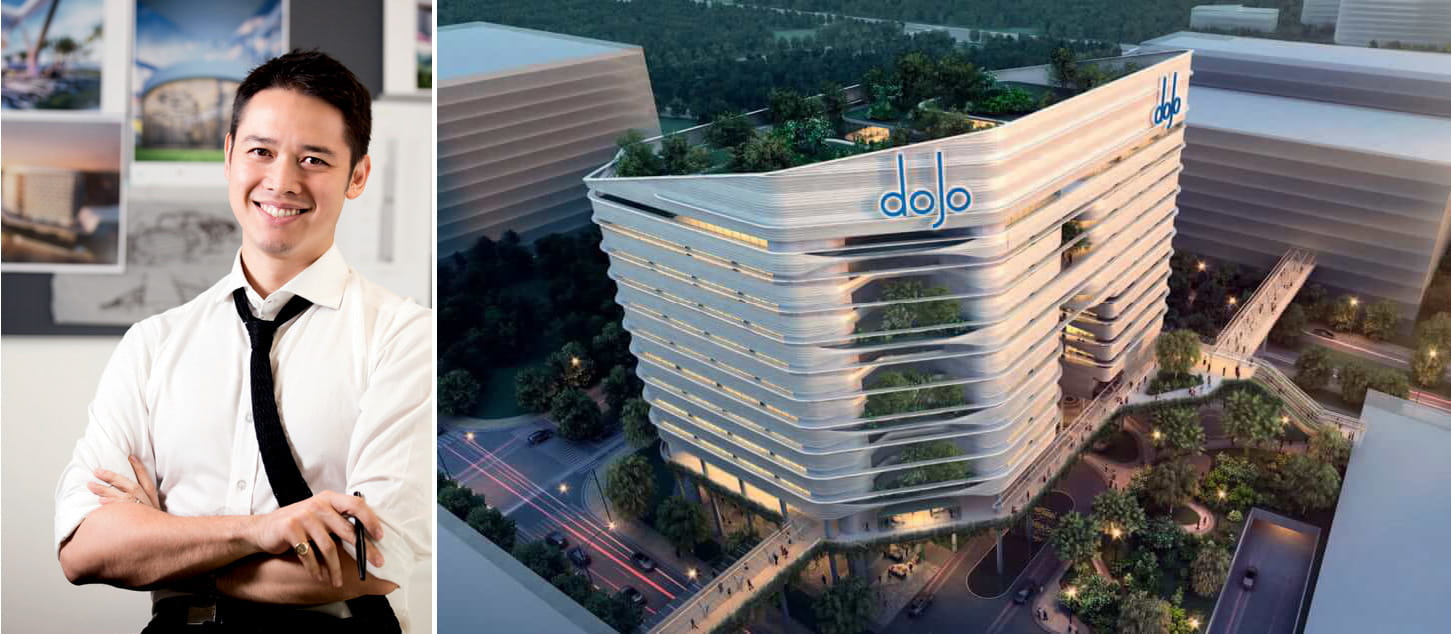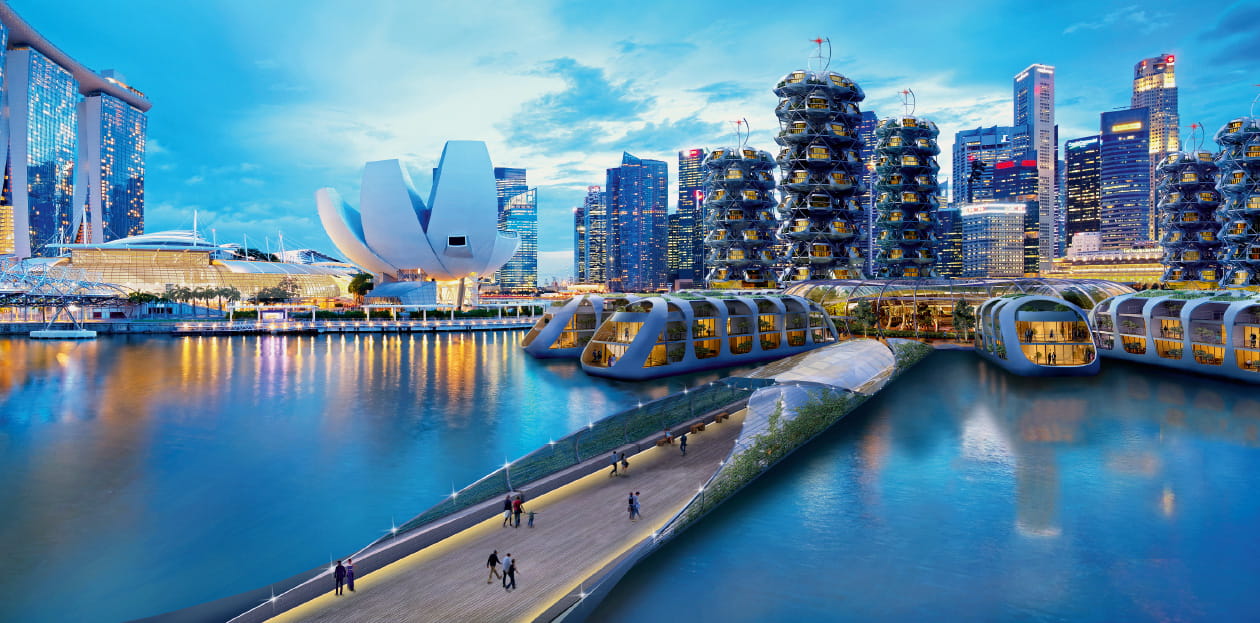Stories > Sketching the Future
Sketching the Future
Eco-architect and TV host Jason Pomeroy traces Singapore’s ability to stay environmentally and culturally sustainable in the face of rapid development.
BY CARA YAP
ured by what he perceived as a land of opportunity, UK-born eco-architect Jason Pomeroy first arrived in Singapore in 2008 to establish the Singapore office of UK-founded design firm Broadway Malyan. Faced with the start of the global financial crisis, he found that work was slow to come, but managed to weather the downturn.
“Everyone experienced the cataclysmic effects of the economic meltdown but, thankfully, Singapore was far more robust than many of the countries I had previously worked in,” he says.
The well-travelled architect – who had spent a year and a half each in Amsterdam, Brussels, Bahrain, Malaysia and the UAE – eventually decided to strike out on his own.
In 2012, he set up Pomeroy Studio. Among its catalogue of sustainable projects is Singapore’s first carbon-negative house in Bukit Timah – which generates more energy than it consumes – and a 3,500sqm sky garden in the Philippines.
THINKING SMART
A decade from when he first set foot on the Little Red Dot, Pomeroy asserts that he has witnessed significant changes in the country – many of which are not bound to its frenetically evolving landscape. “My initial impression of Singapore was that it was a sterile and slightly contrived global city that lacked character and identity. I’m happy to say that this has changed over time. Its burgeoning arts arena is wooing many international artists, while its music scene is also thriving,” he shares.
This increasingly vibrant cultural scene, he says, can be attributed to a more rigorous approach to urban planning – one that views the city as something that’s more than just a financial centre. It’s a topic in which the academic – who has lectured at universities – is well versed. In between designing energy-efficient buildings, he has found the time to create a master plan for a waterfront village in Singapore, as well as host television documentaries. The most recent is an eight-part series on smart cities around the world, which aired on Channel NewsAsia.
“Singapore is embracing the role of technology in enhancing people’s lives. But for all the talk about it being a smart, sustainable city, I think we need to ensure that we do not lose sight of the important role people and culture play in shaping it. I’m heartened to see that there has been a greater push towards thinking about the individual, as opposed to a government-driven, top-down approach,” he shares.

LEFT: Eco-architect Jason Pomeroy has built a career out of creating energy-efficient buildings. RIGHT: A new way of life in Singapore? Pomeroy Studioʼs Pod-Off Grid prototype envisions communities functioning off the grid in open water.
Likening the state to a proud parent, the father of two explains: “It’s easy to want the best for your children. And while you put them through school and sign them up for lots of activities, you sometimes forget about play time.” According to him, now is the time for Singapore to play, and it is doing so heartily – through a burgeoning cultural scene as well as an expanse of events and activities taking place in open spaces, such as the Formula One race, car-free days and Singapore Night Festival. All of these contribute to the country’s liveability.
COUNTRY IN THE GREEN
So what does the architect, who is seen as an authority on urban greenery, think of Singapore’s embrace of green architecture? “I would argue that an architecture of tropical resilience has emerged from this place. It is climatically responsive and sensible to the preservation of water, while holding the ability to help reduce energy consumption by more sustainable means,” he says.
“Singapore Is Making Good Progress In Engaging The Grassroots To Highlight The Importance Of Sustainability.”
Jason Pomeroy, Founder Of Pomeroy Studio
Though he has seen – and designed – his fair share of sustainable buildings around the world, Pomeroy prefers not to comment on how Singapore’s green architecture stacks up against those of other countries. “It is always tempting, for a young and prosperous nation like Singapore, to look over the fence and compare itself to others, but if you are too preoccupied with keeping up with the Joneses, you risk alienating your people.”
He does, however, have praise for the country’s notable eco-friendly buildings. “The National Gallery is a remarkable adaptive reuse of a heritage structure that has provided a wonderful social focal point for Singaporeans and tourists alike. For me, the fact that it’s been sensitively restored to tell a story of Singapore’s past is a good lesson in cultural sustainability,” he says.
On the topic of sustainability, Pomeroy is positive about the Building and Construction Authority’s aim to have 80 per cent of buildings in Singapore Green Mark-certified by 2030. However, he emphasises that getting the public to buy into the common goal of a low carbon future requires a greater understanding of individual agendas. “In terms of creating awareness for the layman, you need a softer approach. Singapore is making good progress in engaging the grassroots to highlight the importance of sustainability. The tone of voice that’s being used in public messages is more relatable, and things like being supportive of car and bike sharing schemes and electric vehicles helps,” he shares.
“For All The Talk About Singapore Being A Smart, Sustainable City, I Think We Need To Ensure That We Do Not Lose Sight Of The Important Role People And Culture Play In Shaping It.”
Jason Pomeroy
But what does he hope for the future of sustainability in Singapore? “I would encourage people to break down the silos between disciplines, especially in the built environment industry. For instance, planners, builders and legislators need to have the common objective of creating a greener urban habitat. I think the future will be very much about the sharing of knowledge and resources to create better products,” he explains.
Policy-wise, Pomeroy envisions a greater deregulation of public utilities, which will provide more opportunities for people to be self-sustaining generators of energy.

The soon-to-be completed Alice @ Mediapolis is a brainchild of Pomeroyʼs that is big on greenery.
“Ultimately, we want to be living in an environment that’s less dependent on fossil fuel. I also see a greater incorporation of greenery within architecture, so the lines between landscape and architecture are blurred,” he adds. It’s an apt observation from someone who designed Alice @ Mediapolis, a richly foliated mixed-use office building in Singapore.
A FINE BALANCE
The Lion City may be where some of Pomeroy’s current major undertakings are, but work also brings him to various parts of the world, from all over South-east Asia to Riyadh, Tokyo and Stockholm. “Singapore is so well connected, it allows me to travel with relative ease to the Middle East,” he says.
While his busy schedule limits his time on the island to around four days a week, he tries to make the most of his weekends by spending time with his family.
“We visit a museum or gallery every Sunday without fail, to keep my two young children culturally topped up. They are absolutely addicted to staring at paintings, sculptures and artefacts of antiquity,” he shares. Describing weekends as food-and drink-fuelled events with friends, the urbanite is able to enjoy a variety of cuisine from a traditional English Sunday roast to local fare, such as spice-laden Peranakan dishes.
Life in Singapore seems to have its own comfortable cadence for the foreigner, who has a close circle of Singaporean friends. “My friends are individuals who have had the privilege of stepping outside of the island and enriching their lives. The fact that they returned to their home country tells me that it has strong values that drew them back, and I am inspired by how they are now making active contributions in their fields of work.”
Perhaps it’s more fitting, for someone who dreams up structures, to decipher a country through its development. “One thing that strikes me is the ‘go get em’ attitude of Singaporeans. I recall travelling frequently to and from Singapore while Marina Bay Sands was being constructed. Each time I got back, I would see a few more floors added to it.” However, he cautions the need to strike a balance between technology and sustainability: “Technology enhances productivity and allows you to create a city in a short period of time, but you should not let it take over society.”
